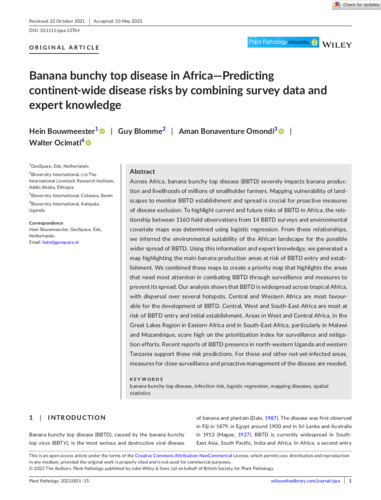Banana bunchy top disease in Africa – Predicting continent‐wide disease risks by combining survey data and expert knowledge
Across Africa, banana bunchy top disease (BBTD) severely impacts banana production and livelihoods of millions of small-holder farmers. Mapping vulnerability of landscapes to monitor BBTD establishment and spread is crucial for proactive measures of disease exclusion. To highlight current and future risks of BBTD in Africa, using logistic regression, the relationship between 1160 field-observations from 14 BBTD surveys and environmental covariate maps was determined. Using these relationships, we inferred the environmental suitability of the possible wider spread of BBTD within the African landscape. Based on environmental suitability and expert knowledge, we then generated a map highlighting main banana production areas at risk of BBTD entry and establishment. We combined these maps to create a priority map that highlights the areas that need most attention in combating BBTD through surveillance and measures to prevent its spread. Our analysis shows that BBTD is widespread across tropical Africa, with dispersal over several hotspots. Central and Western Africa are most favorable for development of BBTD. Central, West and South-East Africa are most at risk of BBTD entry and initial establishment. Areas in West and Central Africa, in the Great Lakes Region in Eastern Africa and in South-East Africa, particularly in Malawi and Mozambique, score high on the prioritization index for surveillance and mitigation efforts. Recent reports of BBTD presence in northwestern Uganda and western Tanzania support these risk predictions. For these and other not yet infected areas, measures for close surveillance and to proactively manage the disease are needed.

